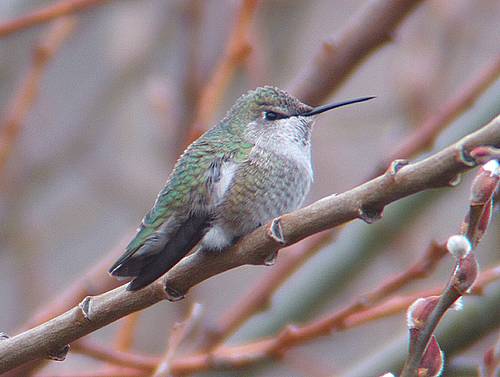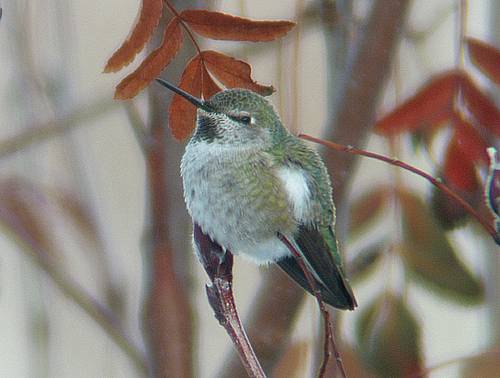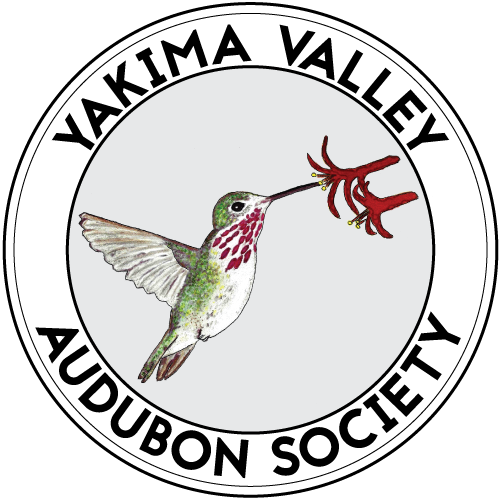Hmm…Did I Just See a Hummingbird?
General ·
Q: It’s fall (or winter) and there are still hummingbirds in my yard - shouldn’t they have migrated by now?
A: The hummingbirds seen in October thru February/March in the valley are almost certainly Anna’s Hummingbirds, a species which is steadily expanding its range northward. This is the only hummingbird species that does not migrate south from our area to winter in warmer climates; rather they are year around residents in Western Washington State with Yakima area populations expanding in recent years.

Q: How do hummingbirds survive in winter? Should I feed them?
A: Hummingbirds are uniquely adapted to surviving winter. They have a very high metabolism which requires a lot of energy to sustain. To conserve energy at night, they go into a state called torpor, where they lower their metabolism to almost nothing (kind of like a really short hibernation) in order to survive the cold.
Many people do not know that the main source of food for hummingbirds is insects rather than nectar. Drinking nectar gives them the energy they need to sustain their metabolism and hunt insects. There are some insects active in winter, but not many, so having a reliable source of nectar is important to their survival. So, if you plan on putting up a hummingbird feeder in the winter, plan on keeping it up until the temperatures warm in the early spring.
If you are putting up a feeder, there are a few things to remember. First, keep the feeder clean. This is essential. Change the nectar at least once a week (more often when it is warmer outside), and clean the feeder every time you change the nectar. Wash the feeder with a mild detergent and hot water and rinse well.
Second, place the feeder out of the reach of cats, at least four feet off of the ground. Third, if it is cold and the feeder freezes, keep a second feeder available. Keep two feeders full of nectar, and when one starts to freeze, bring it inside to thaw and put the other one up. After it gets dark, bring the feeder(s) inside and put them in the fridge until daylight (literally - these birds are hungry when awaking in the morning! It’s best to put feeders out just before daylight).
The recipe for nectar is simple: four parts water to one part sugar. Use only cane or beet white table sugar - NO brown sugar - NEVER use honey or artificial sweetener, and NEVER add red food coloring to the nectar. Bring to a boil, cool and store for a week to 10 days in the fridge.
An alternative to bringing feeders in and out in freezing weather is a heated hummingbird feeder. There are a couple of them on the market locally: Hummers Heated Delight, which is made in Oregon, is a very popular option. There are quite a few people in the Yakima Valley who are using this feeder: https://www.hummersheateddelight.com/
Another option is the Hummer Hearth, sold at Wild Birds Unlimited. This heater is easy to use and matches up perfectly with hummingbird feeders purchased at WBU, if you use them: http://www.hummerhearth.com/
One thing to remember about using heated feeders is that you need to watch the nectar carefully. Because of the heat, it spoils more quickly than you might expect and you may need to change it more often.
Q: Will putting up a feeder for Anna’s hummingbirds keep other hummingbird species from migrating?
A: NO. That is a myth. We have four species of hummingbirds that visit/live in our area for part of the year. Many people keep hummingbird feeders up year long, and the only species that stay into winter is the Anna’s. The other species are genetically programmed to migrate, and a feeder hanging in your yard will not stop them.
Q: Where can I learn more about hummingbirds?
A: There are a lot of resources for learning more about hummingbirds. The Cornell Lab of Ornithology is a good place to start. Their ‘All About Birds’ section is very informative: https://www.allaboutbirds.org/guide/Annas_Hummingbird
And also: https://www.allaboutbirds.org/ (to search for information about other types of hummingbirds, or other bird species.)
Seattle Audubon has information about hummingbirds: http://www.seattleaudubon.org/sas/Learn/SeasonalFacts/Hummingbirds.aspx
There is also The Hummingbird Society: http://www.hummingbirdsociety.org
Here is a link to an ongoing study of overwintering hummingbirds at Boise State University: https://ibo.boisestate.edu/winter-hummers/
